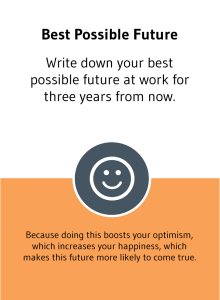
The Science of Your Best Possible Future
Best Possible Future: A Story
Adam was about eight months into his new job and about halfway through his main project (a new app). It was going pretty well. Despite many challenges, Adam and his boss, Chris, were both doing a good job of keeping the team focused and on track.
But despite that, Adam was feeling a bit discouraged. He was getting tired of the project. At his previous job, most projects had lasted less than six months.

In addition to that, the team was discovering bugs and app performance problems that were the toughest they had faced so far. Adam wasn’t feeling optimistic about the future.
Chris noticed that Adam didn’t have the same high energy he’d had earlier in the project. He was working a bit less, taking longer lunches, and his comments during meetings seemed more pessimistic.
During their next one-on-one meeting, Chris said she had a request for Adam. She wanted him to write down his best possible future for three years from now at work. It didn’t need to be a SMARTEST goal, just a vision. Not a fantasy — but a description of what work would be like if everything had gone as well as possible.
Adam’s Best Possible Future
Later, Adam thought for a few minutes, then wrote:
The app project went very well. Despite many tech and people challenges, it shipped on time (and on budget) to rave reviews. I got promoted from Technical Lead to Project Manager for the next major project: an app for sports fans like me!
I grew my people management skills and helped the team stay happy and engaged throughout the project. They did amazing work, and we shipped an app that became a hit.
I was promoted again to Executive Producer. I now lead the development of multiple significant apps at the same time. I’m officially managing people, budgets, and projects. I am a key contributor to the strategy and success of this company.
Chris knew that Adam had written his best possible future before he told her. She could see that his optimism and energy were up, and his comments about the project were more optimistic.
In their next meeting, Adam read his best possible future to Chris. It gave her a clear vision of how Juan wants to learn and grow – and a reason to share his optimism. She can now help Juan work on a professional development plan to meet his career goals while moving the company forward.
The Science
Writing down a “Best Possible Future” boosts optimism. Optimism boosts mood, which boosts brain function — which makes a Best Possible Future more likely to come true.
More than 200 studies show that goal-setting motivates higher performance. Describing your Best Possible Future is a way of identifying long-term goals and inspiring action. Since learning and growth are key to employee engagement, a Best Possible Future also gives supervisors a roadmap to understanding how their direct reports want to develop.
Apply It
Write your own “Best Possible Future” for three years from now at work. If possible, share it with your supervisor(s).
Ask any direct reports to write their own “Best Possible Future” and read it to you. Use this tool to boost your team’s engagement through targeted learning and growth.
Learn More
This study is a great place to start:
- What Is the Optimal Way to Deliver a Positive Activity Intervention? The Case of Writing About One’s Best Possible Selves. Kristin Layous , S. Katherine Nelson, Sonja Lyubomirsky. Research Paper. Journal of Happiness Studies. April 2013, Volume 14, Issue 2, pp 635-654. http://link.springer.com/article/10.1007/s10902-012-9346-2“
(Please note this post is one in a series of blog posts about solutions featured in Choose Happiness @ Work.)